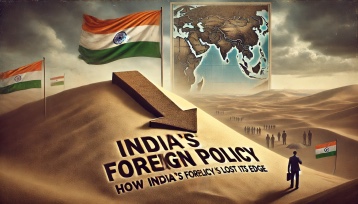India’s foreign policy once stood as a pillar of regional strength, strategic autonomy, and global respect. Today, however, the landscape appears markedly different, with diminished influence among neighbors, increased external pressure, and a retreat from the assertive independence that defined earlier eras. This article explores the contrast between India’s past and present foreign policy, drawing on the legacy of leaders like Indira Gandhi, and critically examines the consequences of recent diplomatic choices.
A Legacy of Strength and Self-Reliance
In the decades following independence, India’s foreign policy was characterized by non-alignment, strategic independence, and a refusal to bow to superpower pressure. This approach was most visible under Prime Minister Indira Gandhi, who steered the country through turbulent times with a clear message: India’s sovereignty and regional affairs were not open to external interference.
Indira Gandhi famously declared, “A nation’s strength ultimately consists in what it can do on its own, and not in what it can borrow from others.”¹ She believed in the necessity of self-reliance, warning that dependence on external powers could compromise national sovereignty and hinder true development.²
Her message to the world was unambiguous: “Our foreign policy is one of friendship for all, hence our nonalignment. We are against the involvement of foreign troops or any other interference in the internal affairs of other countries.”³ She consistently asserted that how India managed its regional relationships-especially with neighbors like Pakistan-was a matter for Indians alone, not for outside powers to dictate.
During the 1971 Bangladesh Liberation War, Indira Gandhi resisted intense US pressure and made it clear to President Nixon and other world leaders that India would not tolerate foreign involvement in its decisions. She stated, “I told him without mincing words that we couldn’t go on with ten million refugees on our backs, we couldn’t tolerate the fuse of such an explosive situation any longer.”⁴ Even as the US sent its Seventh Fleet into the Bay of Bengal in a show of support for Pakistan, India acted decisively, leading to the creation of Bangladesh and a resounding diplomatic and military victory.
The Shift: Erosion of Regional Influence
Contrast this legacy with the present. India’s influence in South Asia has waned, with neighbors like Nepal, Sri Lanka, and Bangladesh increasingly asserting their autonomy and, at times, drifting closer to China. The ouster of Sheikh Hasina in Bangladesh, the rise of new political forces in Sri Lanka, and territorial disputes with Nepal have all contributed to a sense of diplomatic drift.
Where once India’s voice was decisive in the region, today it often finds itself reacting to events rather than shaping them. The growing presence of China in South Asian infrastructure, politics, and economics has further complicated India’s neighborhood policy.
Yielding to External Pressure
Perhaps most striking is the shift in India’s response to global powers, particularly the United States. In recent years, India has complied with US sanctions by halting oil imports from Iran, a key strategic partner, despite the economic and diplomatic costs. This move stands in stark contrast to the spirit of self-reliance and assertive independence championed by Indira Gandhi.
Similarly, after the Pehalgham terrorist attack, India refrained from escalating tensions with Pakistan, reportedly due to US pressure. Unlike the past, when Indian leaders would publicly assert that such matters were “none of America’s business,” today’s responses are more muted and accommodating.
Indira Gandhi’s approach was clear: “We are against the involvement of foreign troops or any other interference in the internal affairs of other countries. We believe in negotiations rather than the use of arms in settling disputes.”³ Her leadership projected confidence and clarity, even in the face of superpower opposition.
The Consequences: A Diminished Role
This retreat from assertiveness has had tangible consequences:
- Loss of Regional Leverage: India’s inability to maintain strong, friendly ties with neighbors has opened the door for rival powers to increase their influence.
- Perceived Weakness: Yielding to external pressure, especially from the US, undermines India’s image as a sovereign and independent power.
- Strategic Uncertainty: India’s current foreign policy appears reactive rather than proactive, lacking the clear vision and self-confidence of previous decades.
What Can India Do to Regain Its Standing?
To reclaim its place as a strong, respected power, India must:
- Reinvigorate its tradition of strategic autonomy and self-reliance, as articulated by leaders like Indira Gandhi.
- Rebuild trust and influence among neighbors through consistent, principled engagement and mutual respect.
- Assert its interests confidently on the global stage, making it clear that matters of national security and regional stability are for India to decide.
Indira Gandhi’s words remain relevant: “A nation’s strength ultimately consists in what it can do on its own, and not in what it can borrow from others.”¹ If India is to restore its foreign policy to its former strength, it must rediscover this spirit of independence and clarity.
Citations
- Indira Gandhi: “A nation’s strength ultimately consists in what it can do on its own, and not in what it can borrow from others.”
- Indira Gandhi on self-reliance and independence
- Indira Gandhi: “Our foreign policy is one of friendship for all, hence our nonalignment. We are against the involvement of foreign troops or any other interference in the internal affairs of other countries.”
- Indira Gandhi’s message to Nixon and the world during the 1971 war



